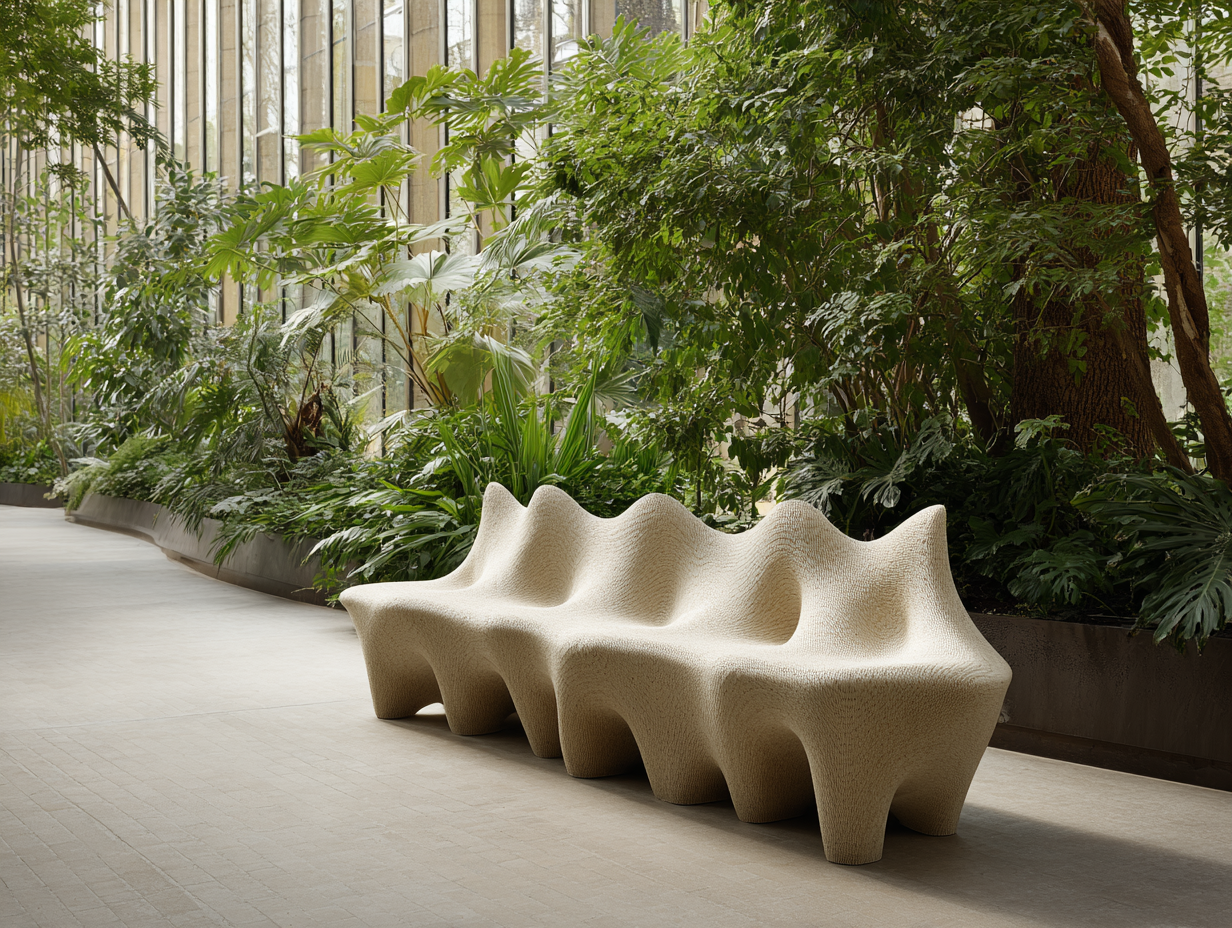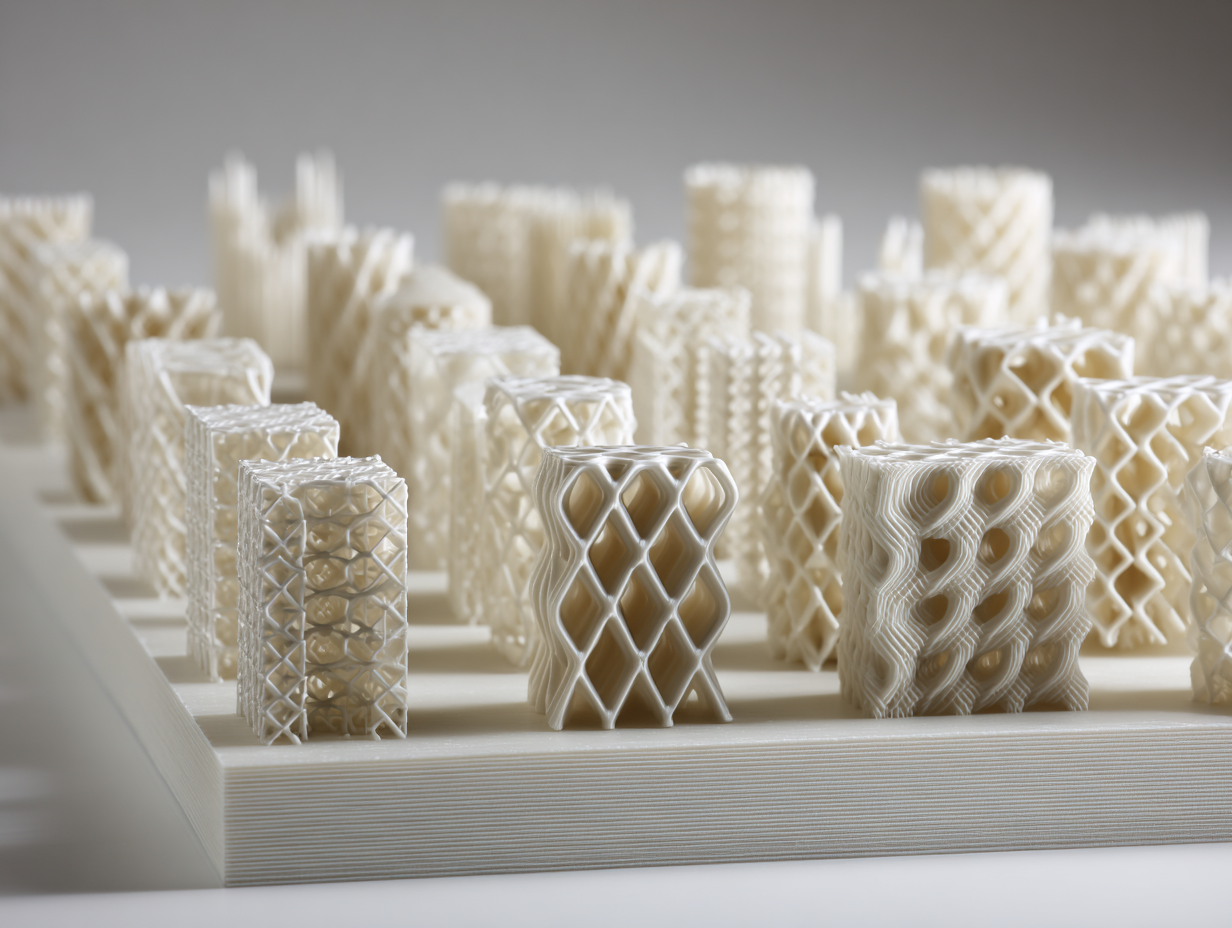
2050년 탄소중립 목표 달성은 더 이상 선택이 아닌 인류의 생존 과제입니다. 전 세계는 탄소 배출 감축을 위해 총력을 기울이고 있으며, 그 핵심에는 탄소 포집·활용·저장(CCUS) 기술이 있습니다. CCUS는 발전소나 공장에서 발생하는 이산화탄소를 대기로 방출하기 전에 포집해 지하에 안전하게 저장하거나, 연료·소재 등 새로운 자원으로 전환하는 기술입니다. 국제에너지기구(IEA)는 이 기술이 2070년까지 전 세계 탄소 감축량의 약 15%를 담당할 것으로 전망하며, 기후변화 대응의 핵심 수단으로 꼽고 있습니다.
탄소 포집(Carbon Capture)은 이러한 CCUS의 기반이 되는 기술로, 대기나 산업 공정에서 배출되는 이산화탄소(CO₂)를 직접 분리·회수해 배출을 차단합니다. 주로 화력발전소, 제철소, 시멘트 공장처럼 배출량이 많은 산업에서 활용되며, 이렇게 포집한 탄소는 탄소 저장(CCS)을 통해 지하에 영구 보관하거나, 탄소 활용(CCU)을 통해 다양한 산업 자원으로 재탄생합니다. 이를 통해 온실가스 배출을 줄이고 기후변화를 완화하는 데 중요한 역할을 하고 있습니다.
두 혁신 기술의 만남, 기후 위기의 해법이 되다

한편, 산업 제조 분야에서는 산업용 3D프린팅(적층 제조)이 패러다임 전환을 이끌고 있습니다. 디지털 설계를 바탕으로 소재를 층층이 쌓아 올리는 이 기술은 복잡한 구조 구현, 소재 낭비 최소화, 분산형 제조를 가능하게 하며 제조업의 미래를 재정의하고 있습니다.
기후 위기 대응이라는 거대한 과제와 제조업의 혁신이라는 강력한 동력이 만나는 지점에서, 탄소 포집 소재 기반의 3D프린팅이라는 새로운 가능성이 떠오르고 있습니다. 이는 단순히 장치를 3D프린터로 제작하는 것을 넘어, 산업용 3D프린팅의 고유한 장점을 활용해 탄소 포집 기술의 효율과 경제성을 근본적으로 혁신하는 것을 의미합니다. 이 두 기술의 융합이 어떻게 기후 위기 대응의 게임 체인저가 될 수 있는지, 소재의 관점에서 심도 있게 살펴보겠습니다.
3D프린팅, 탄소를 잡는 현실 기술이 되다: 실제 적용 소재와 사례

3D프린팅 기반 탄소 포집 기술은 이제 이론을 넘어 현실 세계에서 구체적인 성과를 만들어내고 있습니다. 특히 주목할 만한 점은, 기존에 없던 새로운 기능성 소재를 활용하거나, 기존 소재를 3D프린팅에 최적화하여 그 성능을 극대화하고 있다는 것입니다.
1. CO₂를 흡수하는 콘크리트 (싱가포르 난양공대) 건설 산업은 막대한 양의 탄소를 배출하지만, 3D프린팅 기술은 이 문제를 역으로 활용합니다. 3D프린팅으로 콘크리트 구조물을 만드는 과정에서 포집된 CO₂를 주입하면, 이산화탄소가 콘크리트 성분과 반응해 탄산칼슘으로 영구 고정됩니다. 이는 CO₂를 폐기물이 아닌 건축 자재의 일부로 전환하는 혁신적인 발상으로, 콘크리트의 압축 강도를 37%나 향상시키는 부가적인 효과까지 얻었습니다.
2. 효소를 품은 하이드로겔 바이오 필터 (노스캐롤라이나 주립대) 연구진은 탄산무수화효소를 3D프린팅용 하이드로겔 잉크에 혼합하여 탄소 포집 필터를 제작했습니다. 이는 살아있는 효소의 생화학적 기능을 산업용 3D프린팅의 정교한 구조 설계 능력과 결합한 사례입니다. 1,000시간 이상 작동 후에도 성능을 유지하는 내구성을 입증하며, 바이오 소재 기반의 지속 가능한 탄소 포집 필터 개발 가능성을 열었습니다.
3. 식물성 폐기물 기반 바이오매스 소재 (Marvel Labs) 스타트업 Marvel Labs는 해조류, 커피 찌꺼기, 톱밥 같은 식물성 폐기물을 바인더 제팅 3D프린팅의 소재로 활용합니다. 버려졌다면 분해되며 탄소를 배출했을 바이오매스를 유용한 제품으로 만들면서 그 안에 탄소를 영구적으로 고정시키는 것입니다. 이는 단순한 재활용을 넘어, 제품 생산 자체가 탄소 저감 활동이 되는 ‘탄소 네거티브’ 제조의 새로운 모델을 제시합니다.
4. 고성능 세라믹 흡착제 (텍사스 A&M 대학) 금속-유기 골격체(MOF)나 활성탄 같은 고성능 흡착제는 분말 형태라 가공이 어렵다는 단점이 있습니다. 연구진들은 고온과 부식에 강한 세라믹을 3D프린팅하여, 흡착 성능은 극대화하면서도 가스 흐름 저항은 최소화하는 다공성 구조체를 개발하고 있습니다. 이는 첨단 소재의 잠재력을 3D프린팅이 어떻게 현실화하는지를 보여주는 대표적인 사례입니다.
왜 3D프린팅인가? 탄소 포집 효율을 극대화하는 시너지

3D프린팅과 탄소 포집 기술의 융합은 기존 기술이 직면했던 근본적인 한계를 극복하고 비선형적인 성능 향상을 가능하게 합니다. 그 핵심 시너지는 특히 소재를 다루는 방식과 설계의 자유에서 비롯됩니다.
1. 설계의 자유: 기하학적 최적화를 통한 표면적 극대화 탄소 포집의 효율은 이산화탄소가 흡착제와 얼마나 효과적으로 접촉하느냐에 달려있습니다. 3D프린팅은 이 접촉 면적을 극대화할 수 있는 독보적인 설계 능력을 제공합니다. 기존 제조 방식으로는 구현이 불가능했던 산호나 스펀지 형태의 자이로이드(Gyroid)나 미세 격자(Lattice) 구조를 손쉽게 제작할 수 있습니다. 이는 단위 부피당 표면적을 기하급수적으로 늘려, 가스와 흡착제 간의 반응 효율을 직접적으로 향상시킵니다.
2. 공정 강화: 다기능 통합으로 반응 효율 증대 산업용 3D프린팅의 진정한 가치는 여러 기능을 하나의 부품에 통합하는 데 있습니다. 예를 들어, 탄소 포집 공정에서 발생하는 열은 포집 효율을 떨어뜨리는 주요 원인입니다. 기존에는 별도의 외부 열교환기를 사용했지만, 이는 시스템을 크고 복잡하게 만들었습니다. 미국 오크리지 국립연구소(ORNL)는 다공성 흡착 구조체와 냉각 채널을 내장한 단일 부품을 3D프린팅으로 제작하여, 반응열을 현장에서 즉시 제거함으로써 포집 효율을 최대 15.5%까지 끌어올렸습니다. 이처럼 소재의 특성과 기능적 설계를 하나로 통합하는 것은 3D프린팅만이 가능한 혁신입니다.
3. 연구개발의 가속화: 신소재의 신속한 적용과 검증 새로운 탄소 포집 소재가 개발되어도, 이를 실제 장치에 적용하고 테스트하는 과정은 많은 시간과 비용을 요구했습니다. 산업용 3D프린팅은 이 과정을 획기적으로 단축시킵니다. 디지털 설계 변경만으로 수 시간 내에 새로운 프로토타입을 제작할 수 있어, 다양한 소재와 구조 조합을 빠르게 실험하고 최적의 솔루션을 도출할 수 있습니다. 이는 혁신적인 소재 기술이 실험실을 넘어 상용화로 나아가는 속도를 가속화하는 중요한 동력입니다.
국내 연구 동향과 미래 기술: 살아있는 소재의 가능성

국내에서도 산업용 3D프린팅을 활용한 탄소 포집 연구가 활발히 진행 중입니다. KAIST는 전기로 작동하는 직접 공기 포집(DAC) 시스템을 개발하고 있으며, POSTECH은 포스코와 함께 제철 공정 슬래그를 활용한 인공 산호 입자 개발 등 독창적인 연구를 수행하고 있습니다.
특히 주목할 만한 흐름은 ‘살아있는 소재’의 활용입니다. 세종대학교 연구팀은 광합성을 하는 미세조류를 하이드로겔에 넣어 3D프린팅하는 바이오캐리어를 개발했습니다. 이 구조체는 폐수 속 질소와 인을 제거하는 동시에, 광합성을 통해 이산화탄소를 유기물로 고정합니다. 이는 3D프린팅 구조물이 단순한 필터를 넘어, 스스로 탄소를 처리하는 작은 생태계 역할을 할 수 있음을 시사하며, 미래 도시형 탄소 포집 인프라의 가능성을 엿보게 합니다.
공정 혁신의 촉매이자 미래를 여는 열쇠

산업용 3D프린팅은 더 이상 탄소 포집 기술의 보조 도구가 아니라, 성능과 경제성을 근본적으로 재정의하는 핵심 동력으로 자리 잡고 있습니다. 설계의 자유를 통해 소재의 접촉 표면적을 극대화하고, 다기능 통합으로 시스템을 소형화하며, 분산형 생산으로 공급망의 탄소 발자국을 줄이는 혁신을 주도하고 있습니다.
물론, 대규모 적용을 위한 프린팅 속도 향상이나 소재의 장기 내구성 확보 등 현실적인 과제는 남아있습니다. 하지만 AI 기반 최적 설계, 스스로 손상을 복구하는 자가 치유 소재, 광합성을 하는 살아있는 소재의 등장은 우리가 상상 속에만 그렸던 지능화된 탄소 포집 솔루션이 멀지 않았음을 예고합니다.
GLUCK은 대량생산이 가능한 산업용 3D프린팅 서비스 기업입니다. 작은 아이디어를 반복 가능한 생산성으로 전환해, 현실 가능한 제조 솔루션을 제공합니다.
지금 글룩에 문의해 보세요.
📩 제작 및 상담 문의: support@glucklab.com

A New Convergence for Climate Crisis Response: Carbon Capture and 3D Printing

Achieving the 2050 carbon neutrality goal has become not a choice, but a critical survival task for humanity. The international community is earnestly pursuing a transition to a low-carbon economy through various policy instruments such as emissions trading schemes, carbon taxes, and carbon border adjustment mechanisms. At the core of this global response lies Carbon Capture, Utilization, and Storage (CCUS) technology.
CCUS is a technology that captures carbon dioxide (CO₂) emitted in large quantities from power plants or industrial facilities before it is released into the atmosphere, either storing it permanently or converting it into high-value industrial resources. The International Energy Agency (IEA) projects that this technology will be responsible for about 15 percent of the world's total carbon dioxide reduction by 2070, viewing it as an indispensable tool in carbon reduction strategies.
The Meeting of Two Innovative Technologies: A Solution to the Climate Crisis

Meanwhile, another technological revolution is simultaneously underway in the industrial manufacturing sector: industrial 3D printing, or Additive Manufacturing. This technology builds three-dimensional structures by layering materials based on a digital design, redefining the future of manufacturing by enabling complex structures, minimizing material waste, and facilitating decentralized production.
At the intersection where the grand challenge of climate change meets the powerful driver of manufacturing innovation, a new possibility is emerging: 3D printing based on carbon capture materials. This concept goes beyond simply manufacturing carbon capture devices with a 3D printer. It signifies a fundamental innovation that leverages the unique advantages of industrial 3D printing—its design freedom and process flexibility—to elevate the performance of carbon capture technology beyond its existing limits. This article will take an in-depth look, from a materials perspective, at how the fusion of these two technologies can become a game-changer in responding to the climate crisis.
Why 3D Printing? The Synergy That Maximizes Carbon Capture Efficiency

The convergence of 3D printing and carbon capture technology overcomes the fundamental limitations faced by existing technologies, enabling non-linear performance improvements. The core synergy arises particularly from the way materials are handled and from design freedom.
1. Design Freedom: Maximizing Surface Area and Efficiency through Geometric Optimization The efficiency of carbon capture depends on how effectively carbon dioxide comes into contact with solid sorbents or liquid absorbents. 3D printing offers unparalleled geometric design capabilities to maximize this contact area. It can easily fabricate complex 3D structures, such as gyroids or micro-lattices resembling coral or sponges, which are difficult or inefficient to produce with conventional manufacturing methods. These structures dramatically increase the surface area per unit volume, directly enhancing the reaction efficiency between the gas and the sorbent.
2. Process Intensification: Boosting Reaction Efficiency through Multifunctional Integration A true value of industrial 3D printing lies in integrating multiple functions into a single component. For example, the heat generated during carbon capture processes is a major cause of reduced efficiency. Previously, external heat exchangers were used, but this made systems larger and more complex. The U.S. Oak Ridge National Laboratory (ORNL) solved this by 3D printing a single component with an integrated porous sorbent structure and cooling channels, removing reaction heat on-site and boosting capture efficiency by up to 15.5%. Integrating the material's properties and functional design this way is an innovation only possible with 3D printing.
3. Acceleration of R&D: Rapid Application and Validation of New Materials Even when new carbon capture materials are developed, the process of applying and testing them in actual devices has been time-consuming and costly. Industrial 3D printing drastically shortens this process. A new prototype can be fabricated within hours of a digital design change, allowing for rapid experimentation with various material and structural combinations to find the optimal solution. This dynamic is a crucial driver for accelerating the journey of innovative material technologies from the lab to commercialization.
3D Printing Becomes a Real Technology for Capturing Carbon: Real-World Application Materials and Case Studies

3D printing-based carbon capture technology is no longer just a theory; it is producing concrete results in the real world. What is particularly noteworthy is the use of novel functional materials that did not exist before, or the optimization of existing materials for 3D printing to maximize their performance.
1. CO₂-Absorbing Concrete (Nanyang Technological University, Singapore) The construction industry is a major source of carbon emissions, but 3D printing technology is using this problem to its advantage. By injecting captured CO₂ into concrete structures during the 3D printing process, the carbon dioxide reacts with concrete components and becomes permanently fixed as calcium carbonate. This innovative idea transforms CO₂ from a waste product into a building material, with the added benefit of increasing the concrete's compressive strength by 37%.
2. Enzyme-Infused Hydrogel Bio-Filters (North Carolina State University) Researchers have created a carbon capture filter by mixing carbonic anhydrase enzymes into a 3D-printable hydrogel ink. This case combines the biochemical functions of living enzymes with the sophisticated structural design capabilities of industrial 3D printing. The filter demonstrated durability by maintaining performance for over 1,000 hours of operation, opening up possibilities for sustainable, bio-based carbon capture filters.
3. Plant-Based Biomass Materials (Marvel Labs) The startup Marvel Labs utilizes plant-based waste such as seaweed, coffee grounds, and sawdust as materials for binder jetting 3D printing. As they create useful products from biomass that would have otherwise decomposed and released carbon, they permanently lock the carbon within the products. This presents a new model for "carbon-negative" manufacturing, where the production process itself becomes a carbon reduction activity.
4. High-Performance Ceramic Sorbents (Texas A&M University) High-performance sorbents like metal-organic frameworks (MOFs) or activated carbon are difficult to process in their powder form. Researchers are addressing this by 3D printing with ceramics, which are resistant to high temperatures and corrosion, to create porous structures that maximize sorbent performance while minimizing gas flow resistance. This is a prime example of how 3D printing can realize the potential of advanced materials.
Domestic Research Trends and Future Technology: The Potential of Living Materials

In South Korea, research on carbon capture using industrial 3D printing is also actively underway. KAIST is developing a direct air capture (DAC) system that operates on electricity, while POSTECH is collaborating with POSCO on unique research, including the development of artificial coral particles using steel-making slag.
A particularly noteworthy trend is the use of 'living materials.' A research team at Sejong University has developed a bio-carrier by 3D printing microalgae within a hydrogel. This structure not only removes nitrogen and phosphorus from wastewater but also fixes carbon dioxide into organic matter through photosynthesis. This suggests that a 3D-printed structure can function not just as a filter, but as a small ecosystem that processes carbon on its own, offering a glimpse into the potential of future urban carbon capture infrastructure.
A Catalyst for Process Innovation and the Key to Unlocking the Future
Industrial 3D printing is no longer a supplementary tool for carbon capture technology but has established itself as a core driver that fundamentally redefines its performance and economics. It is driving innovation by maximizing material contact surface area through design freedom, miniaturizing systems through multifunctional integration, and reducing the carbon footprint of supply chains through decentralized production.
Of course, practical challenges remain, such as ensuring the long-term durability of materials and scaling up printing speeds for large-scale applications. However, the emergence of AI-based optimal design, self-healing materials that repair their own damage, and living materials that perform photosynthesis heralds that the intelligent carbon capture solutions we once only imagined are not far off.
GLUCK is an industrial 3D printing service company capable of mass production. We transform small ideas into repeatable productivity, providing realistic manufacturing solutions.
Contact GLUCK today. 📩 For production and consultation inquiries: support@glucklab.com
#GLUCK #글룩 #3D프린팅 #산업용3D프린팅 #탄소포집 #CCUS #탄소중립 #지속가능한제조 #SLA3D프린팅 #대량생산 #DfAM #3D설계 #3D프린팅산업 #3D프린터 #3D모델링 #3D프린팅가격 #3D프린팅업체 #금형제작 #금형 #사출 #몰드제작 #3D프린팅견적 #3D출력 #MassProduction #3DPrinting #LargescaleProduction #AdditiveManufacturing #SLAtechnology #ManufacturingInnovation #DigitalTransformation #SmartManufacturing #CarbonCapture #SustainableManufacturing #CCUS #ClimateTech
'인사이트 (Insights)' 카테고리의 다른 글
| 디지털 기술 유출 : 저렴하고 빠른 제조 서비스의 함정 (1) | 2025.08.29 |
|---|---|
| 산업용 3D 프린팅 몰드를 활용한 탄소섬유 부품 제작 방법 (0) | 2025.08.20 |
| 국방 기술 혁신의 열쇠 :: 산업용 3D프린팅과 소재 개발의 혁신 (4) | 2025.08.11 |
| 그래스호퍼와 3D프린팅, 알고리즘이 빚어내는 제조 산업 (3) | 2025.08.04 |
| 바이오프린팅, '바이오 잉크'를 사용하는 미래 의료산업 (3) | 2025.07.25 |
